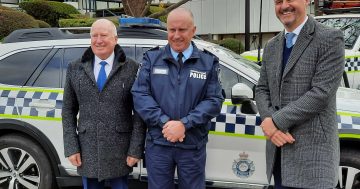
Policing numbers per capita should reach parity with NSW by 2024, the Canberra Liberals said. Photo: Dominic Giannini.
The Canberra Liberals have called on the ACT Government to increase police numbers from the lowest per capita rate in Australia to match NSW by 2024.
The ACT had 879 operational police staff in the last financial year, which is around one officer for every 485 Canberrans, according to the most recent Report on Government Services. The second-lowest is NSW, with one operational police staff member for every 416 residents, the data showed.
President of the Australian Federal Police Association (AFPA) Alex Caruana said members were burnt out and did not have the opportunity to take time off and spend more time with their family as normal public servants do.
An extra 100 to 120 sworn police officers were needed in the ACT, he said.
“They have such a strong comradery that they do not want to take leave and leave their mates thinner on the road,” Mr Caruana told ABC Radio.
“What would help is having more troops on the ground, more people out there to be able to proactively patrol and get the message out there.
“If we are only spending time doing the enforcement then there is no time spent on education and deterrence. We are not educating the public not to do the wrong thing.”

Shadow Police Minister Jeremy Hanson said a new police station was needed to service the Molonglo region. Photo: Dominic Giannini.
Shadow Minister for Police Jeremy Hanson said hard-working front line police officers pleading for more resources through their union are being ignored.
“We are an island within NSW and I do not see why we should have fewer police officers per capita than places like Yass or Queanbeyan,” he said.
Minister for Police and Emergency Services Mick Gentleman criticised Mr Hanson for misinterpreting policing staffing numbers but did not specifically respond to questions in the Legislative Assembly about whether he thought the comments from the AFPA were wrong.
“Canberra is a safe city with low crime rates, which is the best measure that we are adequately resourcing our police force,” he said.
Mr Gentleman said he was not aware of excessive overtime and that the government provided funding for an additional 60 members for ACT Policing.
Mr Hanson also renewed his call for a police station in Molonglo by the end of 2022 to service the area’s growing population.
“Police are stretched to the limit and, as a result, are taking longer to respond to reports of criminal activity. A lack of police presence in Molonglo Valley and surrounding suburbs has resulted in reports of escalated criminal activity,” said Mr Hanson.
“Clearly, there is a need for a permanent police station in the region to service not only the Molonglo community but Weston Creek as well.
“It is not good enough for these suburbs to rely on the Woden Police Station, which is already understaffed and having to cover Woden Valley, Weston Creek and Molonglo.”

Police Minister Mick Gentleman has defended the government spending on police in the ACT. Photo: Michelle Kroll.
Mr Gentleman said there does not seem to be a relationship between station presence and crime prevalence.
“[The ACT] is in a confined area, and police can respond incredibly quickly.”
Chief Police Officer Neil Gaughan agreed, having previously told Committee Hearings that the compact nature of the Territory meant that he could reallocate policing resources quite quickly.
“We will adapt as things emerge, and that is what the community expects. It is a juggling act. I am not going to sit here and say that I am flushed with resources and I have the ability to be everywhere at every time,” he told the Committee in February.
Reports of crime in the Molonglo district have been going up since 2014, but Mr Gaughan said it was important to note that reports of crime will increase as the population does in any given area.
“The other thing that links to increasing crime in any area is that issue of population growth. The fact is that as Molonglo continues to grow in population, we are going to see an increase in reportable crime,” he said.




















